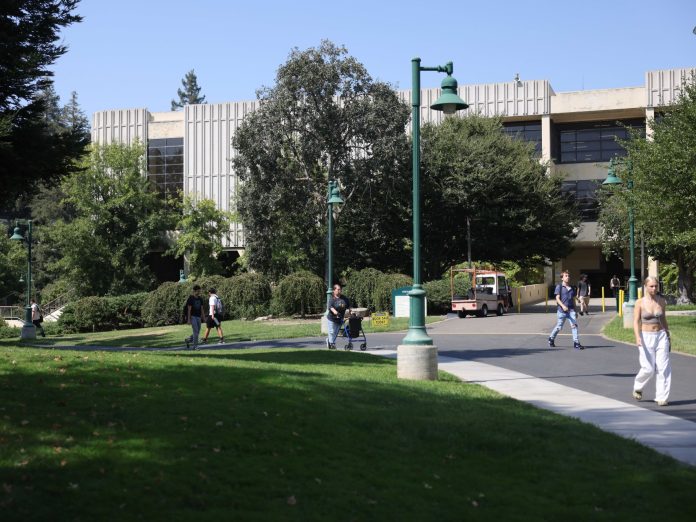Freshman students at Sacramento State will soon be required to live their first two years on campus, and the university is looking to expand its housing to accommodate them.
The university says that starting in Fall 2026, Sac State will implement a two-year residential requirement for non-transfer, first-year students.
Sac State President Luke Wood announced this new housing requirement in August during his 2025 Fall Address when talking about providing for students’ basic needs.
He recalled living in his car while attending Sac State or going days without eating on campus. Wood said after he began sharing this story publicly as president, he was approached by students who said they were facing similar situations.
“I was glad to hear that was inspirational in some ways, but I was really more upset that we still have this happening here on campus,” he told the audience.
Wood said the live-on-campus policy would be geared toward students, “who are from a certain distance away… not for our local students here,” adding that, “when students are coming here we know that they have a roof over their head, and know where their next meal is coming from.”
Wood said the policy was also aimed at improving students’ academic success by providing them with more resources. “When you’re a commuter student and you go home, you go home,” he said.
“When you’re a student who lives in our residence hall and you go home, you go home to academic advising and tutoring, and supplemental instruction, and resident hall advisors, and access to all the events that are happening on campus. You never stop learning.”
University officials note other benefits among students who live two consecutive years on campus include “higher academic achievement, greater sense of belonging, and stronger personal development outcomes.”
The new living requirement will not apply to all freshmen. A policy fact sheet released by the university says students living with immediate family within 50 miles of campus will be exempt in 2026-27. This range will shrink to 30 miles or less in 2027-28.
Other outlined exceptions include students who:
- Are aged 21 or older by the first day of class during the specified term.
- Are considered independent by the Free Application for Federal Student Aid (FAFSA).
- Are active-duty service members or veterans.
- Have a demonstrated and verified financial hardship.
- Who are required to live at their job site as a care provider.
- Are participating in a study-abroad or study-away program or internship.
- Have a documented medical or disability condition that cannot be accommodated in campus housing.
Student housing expansion plans
In an Instagram post last Thursday, Wood said Sac State is starting the process of expanding its affiliated student housing as this requirement comes into effect. Wood reiterated that Sac State serves lower-and-middle-income students who may struggle to find shelter or food security.
“This is one reason why student housing (e.g. residence halls, affiliated housing complexes) is so essential,” he wrote.
Wood characterized the effort as part of Sac State’s work to “shed our past as a commuter campus and become a more residential community,” an idea also promoted by his predecessor, former President Robert Nelsen.
According to the 2025 Sac State Fact Book the university had almost 31,000 enrolled undergraduate and graduate students in Fall 2024, including nearly 4,000 first-year attendees. Of that entire student body, only 3,200 lived on campus.
Wood also noted the university has significant waiting lists for students seeking campus housing. Wood said the process would help meet Sac State’s current and future demand, especially as the new living requirement is implemented.
University officials say plans are in the works to increase the number of beds available in campus residence halls. The new Mt. Whitney Hall is expected to open in Fall 2026 and provide 335 new beds for first-year students. Another 160 beds for incoming students will be added in Riverview Hall by converting upper-division housing.
In September the university also broke ground on a new campus-affiliated housing project along College Town Drive called Hornet Place, which will house more than 350 students beginning in Fall 2027.
Despite Wood’s message and goals, his post drew criticism. Commenters questioned how exactly the on-campus living requirement would help low-middle income students.
Some voiced concerns about decreasing affordability and talked about why some students might prefer to commute or find a place off campus. Others criticized increases in Sac State’s tuition costs, along with parking and meal plan requirements that could place additional financial burdens on students.
Sac State’s living expense estimate for the 2025-26 school year is $19,644 for on-campus living, compared to $22,140 for living off campus or $10,792 for living with parents.
Living requirements at California public universities
Sac State is not unique within the Cal State University system in requiring certain first-year students to live on campus, though there is no systemwide policy.
The 2025 Cal State University Systemwide Housing Plan Update submitted to state officials in July showed more than half of the CSU campuses do not have a first-year live-on requirement as of Fall 2024, though some like Sac State have since changed or modified their status.
CSU campuses with these requirements include Bakersfield (one year), San Diego (two years) and San Marcos (one year). CSU Monterey Bay suspended its sophomore live-on requirement due to increased demand for university housing, but still requires it for freshman. San Jose State, meanwhile, suspended its first-year on-campus living policy for 2025-26 as more classes moved online.
Two polytechnic universities, Cal Poly and Cal Poly Humboldt, also require two years of on-campus living, with the former expanding this requirement to all first-year students across all colleges for Fall 2026 as additional campus housing became available. The third, Cal Poly Pomona, paused its first-year student residential requirement for the 2025-26 academic year.
Still others like CSU Stanislaus say while first-year on-campus living is not required, it is “highly recommended.”
None of the 10 University of California system schools have blanket requirements for first-years to live in on-campus housing. However several universities, including UC Davis, provide housing guarantees for incoming students.
Editor’s note: CapRadio is licensed to Sacramento State, which is also an underwriter.
CapRadio provides a trusted source of news because of you. As a nonprofit organization, donations from people like you sustain the journalism that allows us to discover stories that are important to our audience. If you believe in what we do and support our mission, please donate today.








